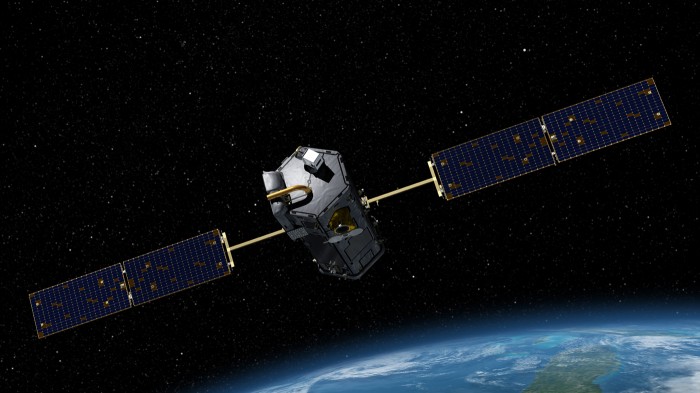Seeking Answers in Space for Accurate Emissions Data
Every 99 minutes a NASA satellite orbits the planet, capturing a million measurements a day of the carbon dioxide in the Earth’s atmosphere. It’s part of an experiment that scientists hope will one day result in a fleet of satellites that reliably and accurately measure carbon dioxide from regions, countries, and even specific cities and large emissions sources like power plants.
Sometime in the coming months China is expected to launch two more satellites, joining NASA’s (called the Orbiting Carbon Observatory-2, or OCO-2) and a Japanese satellite called GOSAT. The Chinese probes are part of the Chinese Academy of Sciences’ effort to more accurately track greenhouse-gas emissions from the world’s largest source of carbon pollution.
These are early attempts to obtain reliable data on a crucial scientific question: how much carbon dioxide is really being added to the atmosphere? Today, national carbon emissions are essentially self-reported, based largely on statistics on the amount of fossil fuels burned in each country. Such estimates are notoriously unreliable, particularly in the developing world, which now accounts for 60 percent of the world’s carbon dioxide emissions (China, for example, admitted last November that it has burned up to 17 percent more coal each year than previously reported.)
“Space-based monitoring of CO2 is the most powerful reality check against governments self-reporting their CO2 inventories and fluxes,” says John O. Niles, executive director of the Carbon Institute.

Ground-based recording stations accurately monitor carbon dioxide concentrations in the atmosphere, but they cover only a fraction of the Earth’s surface, mostly in North America and Western Europe. Even OCO-2 only covers a narrow swath on every orbit, covering only 7 percent of the total surface every month. What’s needed, according to David Crisp, the science team leader for OCO-2, is a fleet of satellites, at least three in low-earth orbit and three in geostationary orbit.
In October the European Commission released a plan for such a system. It will cost billions, will in all likelihood face objections from countries resistant to the idea of an international greenhouse-gas monitoring system, and will in any case not launch until at least the 2030s.

What’s more, while GOSAT and OCO-2 have been mostly successful, the technology is not yet fully proven. Satellites measure carbon dioxide in the atmosphere using spectrometers, which detect the absorption of light by various molecules with a high degree of precision. Since carbon dioxide and oxygen absorb only certain colors of light, the satellites can measure the number of those molecules in a given column of air between the surface and the satellite. Complicating those measurements are all the many things occurring in Earth’s atmosphere, such as wind (which disperses the carbon dioxide) and clouds. Although OCO-2 takes about a million measurements a day, only 100,000 of them are usable, clear-sky measurements. And even NASA’s powerful supercomputers are not yet fast enough to perfectly crunch all that data. “We are improving the algorithms” to analyze the data, says Crisp, “but they’re not yet yielding the accuracy that we need.”
Newer versions of both GOSAT and OCO-2 are scheduled to launch in 2018, and there are plans for at least five more probes, which could form an integrated fleet, sometime in the 2020s. The European Commission report called for “an integrated observation system dedicated to the monitoring of fossil carbon dioxide emissions” that would “monitor and verify the compliance of parties to international climate agreements.” How such a system would be administered, whether countries would accept its findings, and how those findings would lead to enforcement of emissions-reduction targets are all questions that have yet to be explored, much less answered.
Satellite-based systems can “produce reliable, increasingly high-resolution data that can be independently replicated,” says Niles. “On the other hand, whether space-based CO2 monitoring will be effective at providing data that changes behavior is another question altogether.”
Keep Reading
Most Popular
Large language models can do jaw-dropping things. But nobody knows exactly why.
And that's a problem. Figuring it out is one of the biggest scientific puzzles of our time and a crucial step towards controlling more powerful future models.
How scientists traced a mysterious covid case back to six toilets
When wastewater surveillance turns into a hunt for a single infected individual, the ethics get tricky.
The problem with plug-in hybrids? Their drivers.
Plug-in hybrids are often sold as a transition to EVs, but new data from Europe shows we’re still underestimating the emissions they produce.
Stay connected
Get the latest updates from
MIT Technology Review
Discover special offers, top stories, upcoming events, and more.